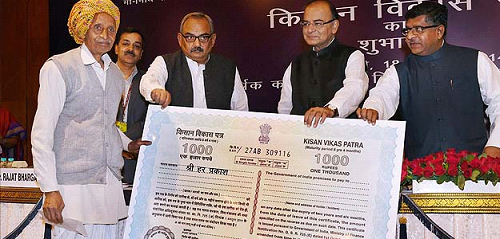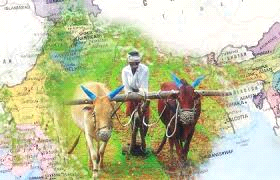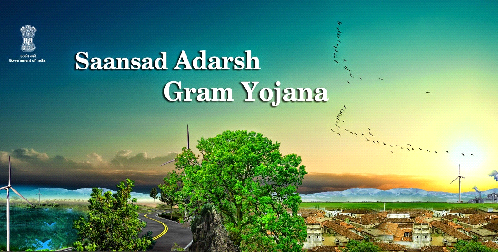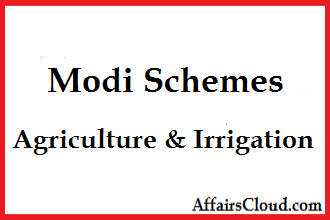Dear Readers & Aspirants, We collected Modi Schemes in Agriculture & Irrigation and make it in PDF format. We Hope it will definitely help you for your SBI PO,IBPS,RBI assistant and many more upcoming Exams. All the Best My Dear Aspirants & Readers.
- Modi Schemes: Banking & Insurance Part 1 PDF
- Modi Schemes: Technology Part 3 PDF
- Modi Schemes: Environmental and Health Part 4 PDF
- Modi Schemes: child and Women Empowerment Part 5 PDF
Kisan Vikas Patra (KVP) Re-Introduced
- The re-launched Kisan Vikas Patra (KVP) will be available to the
- investors in the denomination of Rs. 1000, 5000, 10,000 and 50,000, with no upper
- ceiling on investment. The certificates can be issued in single or joint names and can be transferred from one person to any other person / persons, multiple times. The facility of transfer from one post office to another anywhere in India and of nomination will be available. The certificate can also be pledged as security to avail loans from the banks and in other case where security is required to be deposited. Initially the certificates will be sold through post offices, but the same will soon be made available to the investing public through designated branches of nationalised banks.
- Kisan Vikas Patras have unique liquidity feature, where an investor can, if he so desires, encash his certificates after the lock-in period of 2 years and 6 months and thereafter in any block of six months on pre-determined maturity value. The investment
- made in the certificate will double in 100 months.
- Reintroduction of Kisan Vikas Patra (KVP) is a welcome step not only in the
- direction of providing safe and secure investment avenues to the small investors but will
- also help in augmenting the savings rate in the country. The scheme will also safeguard
- small investors from fraudulent schemes. With a maturity period of 8 years 4 months, the collections under the scheme will be available with the Govt. for a fairly long period to be utilized in financing developmental plans of the Centre and State Governments and will also help in enhancing domestic household financial savings in the country.
* INTEREST RATE –8.7%

HISTORY__
Kisan Vikas Patra (KVP) – a certificate savings scheme was launched by the Government on 1st April, 1988. The scheme provided facility of unlimited investment by way of purchase of certificates from post offices in various denominations. The maturity period of the scheme when launched was 5 ½ years and the money invested doubled on maturity.
The scheme was very popular among the investors and the percentage share of gross collections secured in KVP was in the range of 9 % to 29 % against the total collections received under all National Savings Schemes in the country. Gross collections under the scheme in the year 2010-11 were Rs. 21631.16 crores which was 9 % of the total gross collections during the year. In the year of its closure, the scheme secured gross collections of Rs. 7575.95 crores (April 2011 to November 2011).
A.Krishi Amdani Beema Yojana
- To give an impetus to the dying agricultural practice
- There is 14 crore hectares of agricultural land in India, of which only 44 per cent in under irrigation
- Pradhan Mantri Gram Sinchai Yojana would be introduced so that more agricultural land is irrigated.
- Talking about the plight of small and marginal farmers he said that most of them were leaving the agricultural practice because of the uncertainty over the produce and returns.
- Krishi Amdani Beema Yojana so that the farmers don’t bear any financial burden if their produce gets destroyed due to unexpected weather or for any other reason.

B.Pradhan Mantri Gram Sinchai Yojana
- ensure water supply to farmers round the year.
- basic contours of the agri-irrigation programme would be on lines of the PMGSY, under which each irrigation project would be selected for releasing funds by the state government after seeking nod of the concerned Zilla Parishad.
- importance in the wake of poor implementation of various irrigation projects in some states despite release of central funds by different ministries under various schemes for several years.
- Besides, water is necessary for farmers as country’s 50 per cent of the agriculture land is rainfed.

C.Pradhan Mantri Sansad Adarsh Gram Yojana
The Saansad Adarsh Gram Yojana was launched last week, for the development of model villages. Under the Yojana, Members of Parliament (MPs) will be responsible for developing the socio-economic and physical infrastructure of three villages each by 2019, and a total of eight villages each by 2024.
The first Adarsh Gram must be developed by 2016, and two more by 2019. From 2019 to 2024, five more Adarsh Grams must be developed by each MP, one each year. This implies that a total of 6,433 Adarsh Grams, of the 2,65,000 gram panchayats, will be created by 2024. Key features of the Yojana are outlined below.

Objectives
Key objectives of the Yojana include:
- The development of model villages, called Adarsh Grams, through the implementation of existing schemes, and certain new initiatives to be designed for the local context, which may vary from village to village.
- Creating models of local development which can be replicated in other villages.
Identification of villages
MPs can select any gram panchayat, other than their own village or that of their spouse, to be developed as an Adarsh Gram. The village must have a population of 3000-5000 people if it is located in the plains, or 1000-3000 people if located in hilly areas.
Lok Sabha MPs can choose a village from their constituency, and Rajya Sabha MPs from the state from which they are elected. Nominated members can choose a village from any district of the country. MPs which represent urban constituencies can identify a village from a neighbouring rural constituency.
Funding
No new funds have been allocated for the Yojana. Resources may be raised through:
- Funds from existing schemes, such as the Indira Awas Yojana, Pradhan Mantri Gram Sadak Yojana, Mahatma Gandhi National Rural Employment Guarantee Scheme, and Backward Regions Grant Fund, etc.,
- The Member of Parliament Local Area Development Scheme (MPLADS),
- The gram panchayat’s own revenue,
- Central and State Finance Commission Grants, and
- Corporate Social Responsibility funds.
D.Soil Health Card Scheme for Every Farmer
AIM_
Farming as an activity contributes nearly 1/6th of our Gross Domestic Product and a majority of our population is dependent on it for their livelihood. Deteriorating soil health has been a cause of concern and that has been leading to sub optimal utilization of farming resources. Imbalanced use of fertilisers, low addition of organic matter and non-replacement of depleted micro and secondary nutrients over the years, has resulted in nutrient deficiencies and decrease in soil fertility in some parts of the country.
- Soil health needs to be assessed at regular intervals so as to ensure that farmers apply the required nutrients while taking advantages of the nutrients already present in the soil.
- Government has launched a scheme to provide every farmer a Soil Health Card in a Mission mode. The card will carry crop wise recommendations of nutrients/fertilizers required for farms, making it possible for farmers to improve productivity by using appropriate inputs.
- Central Government provides assistance to State Governments for setting up Soil Testing Laboratories for issuing Soil Health Cards to farmers. State Governments have adopted innovative practices like involvement of agricultural students, NGOs and private sector in soil testing, determining average soil health of villages, etc., to issue Soil Health Cards.
- A Soil Health Card is used to assess the current status of soil health and, when used over time, to determine changes in soil health that are affected by land management. A Soil Health Card displays soil health indicators and associated descriptive terms. The indicators are typically based on farmers’ practical experience and knowledge of local natural resources. The card lists soil health indicators that can be assessed without the aid of technical or laboratory equipment.

BENFITS
- The scheme will provide all 145 million farm owners in the country with a soil health card in the next three years.
- The budget allotted Rs.100 crore for issuing cards and an additional Rs.56 crore to set up 100 mobile soil testing laboratories across the country.
- The soil health card details existing nutrient status of the soil and crop-wise recommendations of nutrients and fertilizers required, making it easier for farmers to improve productivity by using appropriate inputs.
- “Applying fertilizer, best quality seeds and ample water is not enough. Farmers should nurture their soil and know what inputs to use and in what quantities,” Modi said while launching the scheme. “Starting soil health laboratories could be an employment avenue for rural youth. In Gujarat where every farmer has a soil health card unnecessary expenses on inputs have come down and farmers have saved a lot of money.”
- The agriculture ministry released Rs.86 crore for the soil health card scheme. In comparison, between 2007-08 and April 2014, the ministry had spent Rs.112 crore on the scheme. The flagship scheme of the ministry has been sanctioned Rs.568 crore for the next three years.
- Imbalanced use of fertilizer is has led to declining crop productivity in the country, further fuelled by a skewed fertilizer policy where urea is heavily subsided, leading to overuse.
- While urea consumption increased from 59% to 66% of total consumption in 2012-13 over 2010-11, per hectare consumption of fertilizer declined from 140kg to 128kg over the same period, noted the Economic Survey of 2014. Current trends in farm output reveal that the marginal productivity of soil in relation to the application of fertilizers is declining, it reported.
Note*__
National Project for Management of Soil Health and Fertility, was launched during 2008-09 by the previous United Progressive Alliance government.
- Programme started in rajasthan
- SHC issued in punjab




